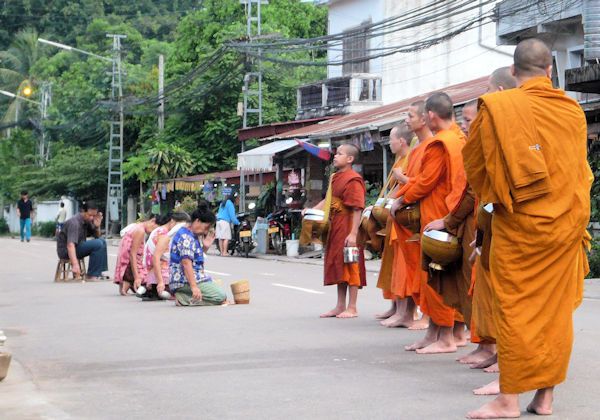
読経する托鉢僧たち↑(2009年5月16日、ビエンチャン、ラオス)

托鉢↑(2008年11月13日、サワナケート、ラオス)
ラオス人を支えているものに信仰心があります。信仰心のおかげでラオス人はいつも幸せです。
毎朝、私のアパートの前をオレンジ色の袈裟を身に付けたお坊さんの一団が歩いて来ます。タクバートゥ(托鉢)です。アパートの大家さん夫妻、隣の奥さんが、道路の脇に座り、お坊さんにお布施(喜捨)をします。お坊さんが肩から提げている入れ物の中に、ご飯、果物、お菓子、お金等を入れています。お坊さんへのお布施が終わると、お坊さんたちは立ち止まって一斉に読経をします。大家さんらは、座ったまま頭を垂れて読経を聞いています。毎日、毎日、同じことが繰り替えされます。
ラオスは、14世紀半ばに統一国家ランサン王国として成立し、それ以来ラオスの宗教は、伝統的に仏教です。
それが、ベトナム戦争が終了した1975年、ラオス人民革命党が政権を握り社会主義政策が推し進められ、布教活動は禁止され、仏教は迫害されました。生産活動に一切従事しない僧侶は、共産主義路線と相いれないためです。この時に海外に逃げ出した僧侶は多くいます。(続く)
【Bon appétit !】
The best rice for the tak bat ritual is prepared by the almsgivers themselves. The locals wake up early to prepare a batch of sticky rice, which they then scoop generously into each monk's bowl as the line files past.
For hundreds of years, the ritual has cemented the symbiotic relationship between the monks and the almsgivers who maintain them - by feeding the monks and helping the laypeople make merit, tak bat supports both the monks (who need the food) and the almsgivers (who need spiritual redemption(救い)).
(https://www.tripsavvy.com/tak-bat-luang-prabang-1629459)
